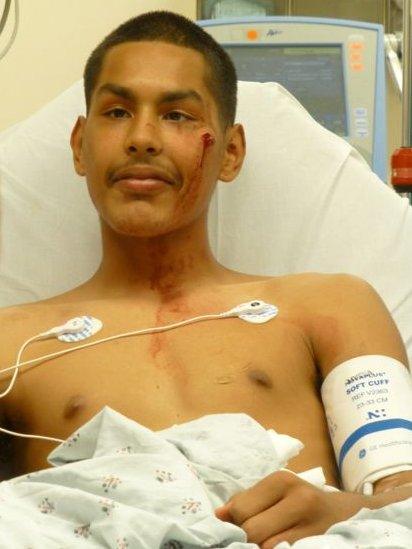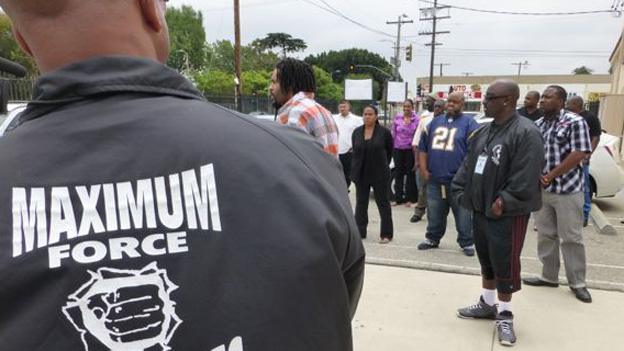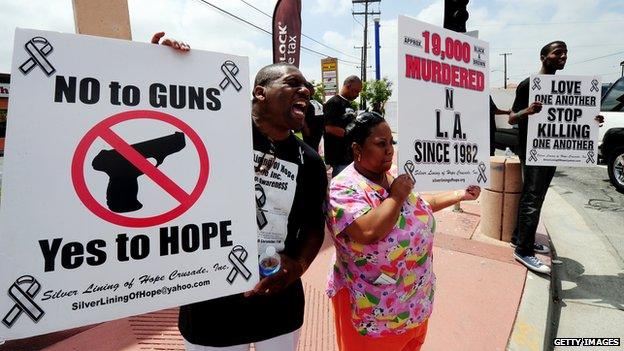How Los Angeles surgeons cope in the gang war zone
- Published
Frank Gardner, himself a gunshot victim, speaks to other survivors in Los Angeles
Around 2,500 gunshot wounds a year are recorded in Los Angeles County, not including fatalities. That is at least six people shot and wounded every day. But how do paramedics and surgeons deal with such a tide of bloodshed?
It's just past 21:00 on a Friday and Dr Peep Talving glances at his waist.
His bleeper has gone off, signalling a TTA (trauma team activation).
His team get ready to receive a patient with potentially life-threatening gunshot injuries.
The LA County & University of Southern California Hospital is a government-run hospital serving an overwhelmingly poor area.
Up on the roof we join Dr Talving and the medics as the landing lights of a helicopter draw closer and it touches down.
I had expected a mad dash of medics towards the sliding door, perhaps a scene of mild panic and confusion.
But this is a normal event here, on a normal night, and they stroll towards the helicopter and speak in calm, unhurried tones.
"Four GSW [gunshot wounds] to the buttocks and legs. BP [blood pressure] stable. No other visible injuries," says Dr Talving, who is Swedish.
The paramedic passes on the basic facts to the trauma team as we go down in the lift.
The patient is 'a frequent flyer'
Around half of all homicides are gang-related, and the Los Angeles Police Department estimates LA has 450 gangs and a total of 45,000 members, known as gangbangers.
The patient on the gurney, his body and face covered in tattoos, is talking calmly to the medics. It turns out he has been shot before and he recites the date with pride.
Someone turns to me and whispers: "He's a frequent flyer."
"I'm not saying he's a gangbanger but he certainly fits the profile," says a policeman.
In the resuscitation room he is heaved onto a bed. Blood is oozing from several bullet holes in his legs - one bullet passed through his foot as he fled his attackers - but he is totally calm.
"Unbelievable," says a nurse. "His heart rate is not even slightly raised. He'll wear this as a badge of honour when he gets out."
As a multiple gunshot wound victim myself - I was shot while on assignment in Saudi Arabia nine years ago - I have come here to find out how hospitals in LA deal with the daily catalogue of gun crimes.

Miguel, a 16-year-old schoolboy, had a lucky escape after being shot at by a gang. Photo by Frank Gardner
In another cubicle a patient is being treated for a bullet through the knee. He was shot on the streets of East Los Angeles, almost certainly by a gang, and does not want to talk to the police.
'Stop internal bleeding'
He is lucky. None of the bullet wounds is serious and Dr Talving decides they do not need surgery. He will go home before too long.
But the next casualty is in a more serious condition.
He has two entry wounds in his side and two exit wounds.
"It looks like a through-and-through," says his surgeon, Dr Kenji Inaba, scanning the X-rays, "but he is quite haemodynamically unstable and we need to open him up to stop the internal bleeding."
In the operating room, after we have all donned scrubs, masks and visors, the team begin a laparotomy. It starts with a scalpel incision most of the way down the middle of the torso then a surgeon follows up with a Bovie pen.
It emits an electrical charge and cuts through flesh but healing is much quicker than with a knife.
Dr Kenji Inaba operates on a gunshot injury victim
As the operation proceeds, a deputy from the LA County sheriff's department is waiting outside in the corridor for news.
World-renowned
She needs to know if the patient will live or die.
If he lives, it is classed as an attempted homicide. If he dies it becomes a murder investigation and detectives would need to be quickly mobilised.
"He'll live," Dr Inaba tells her. She smiles and goes off to file her report.
Ten years ago that might not have been the case.
The way in which this hospital and other "Level 1" US trauma centres treat gunshot injuries has improved dramatically.
The head of the trauma unit is a world-renowned Greek surgeon, Dr Demetrios Demetriades, known as Double D.
He has been here since 1992 and overseen major changes.
"One of the main reasons which made a huge difference in outcomes is the creation of trauma centres. In severe trauma, if you go to a trauma centre the chances of survival increase by about 25%," he says.

Former gang members learn how to defuse tension on the streets of Los Angeles. Photo by Frank Gardner.
Nowadays best practice is what they call "scoop and run" instead of "stay and play", meaning getting the injured person to the nearest trauma centre as fast as possible.
Another major change is in what happens once the patient is wheeled into the hospital.
In the past, surgeons would attempt full invasive surgery in the first 24 hours.
Damage control
"The patient would all be stitched up beautifully but then they would die. The body just couldn't take it," says Dr Inaba.
So now it is all about damage control and stabilisation, stopping the internal bleeding and leaving the fiddly until later.
In my case I was incredibly lucky - the South African surgeon, Dr Peter Bautz, who operated on me in 2004,, external was one of the early pioneers of this new method.
It was controversial then but it saved my life.
Dr Demetriades says the death rate for gunshot wounds 10 years ago was seven per 100,000. Now it is three per 100,000.
Andrew Blankstein, Pulitzer Prize-winning crime reporter for the Los Angeles Times, says: "If you look at most of the crimes in LA and LA County, they're gun crimes.

Danielle Lewis (centre) demonstrates at the site in Compton where her football star son, Dannie Farber, was killed by a gang member
"They're generally the result of warring gangs, over drugs, over turf, by people who either know each other or come across each other. Random, stranger-on-stranger crime that people fear the most is fairly remote here," he adds.
Carlos Barientos was shot by a gang in March, possibly a case of mistaken identity.
Near death
He was shot 16 times and is still in a hospital bed, hooked up to tubes and monitors, his eyes yellow and jaundiced from infections and medication, his voice weak and rasping.
"I woke up three weeks later," he tells me. "I just told God, 'Please take care of me. I have my little daughter. I love her. Keep me strong.
"I mean, it could happen to anybody. It happens to innocent people. They say I'll pull through. You know, I thank God that I'm still alive".
Dr Demetriades has the last word: "There is a culture out there which glamorises gang life. They have fast cars, they deal with drugs and they think that's a great life - until they get a gunshot injury and then they realise that it's a very different story.
"Once they get near death, and once they see their mothers and fathers in tears and in suffering and pain next to them, a lot of them get the message."
You can follow Frank Gardner on Twitter at @FrankRGardner
Watch Frank Gardner's report in Our World: The Violent Heart of LA on the BBC News Channel on 1 June at 05:30 BST, repeated at 21:30 BST and again at 03:30 BST on 2 June. Or catch it later on the BBC iPlayer.
- Published7 April 2013